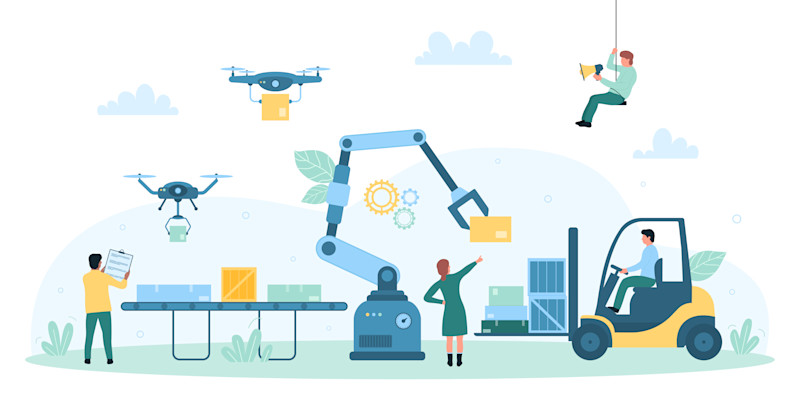TECHNOLOGY
Is Automation the New Lean?
Since its early stages, automation has been seen as a way to increase output. Recent advancements have improved automation’s productivity in the same manner that lean principles would – by eliminating waste. Transport, inventory, motion, waiting, overproduction, overprocessing, and defects are the seven types of waste.
The growth of enabling tech and digital manufacturing pushes automation, which provides a broader set of solutions than a robotic arm, as a potential answer to waste. Some operations can be automated with fixturing. For example, vision systems can guide robots and inspect parts in a static fixture. Automating material handling from stock to stock can reduce transport, waiting, and motion. Coupling automated data capture can reduce defects. While the technologies are available, this emphasizes the importance of humans, who still have to identify, design, and implement such solutions.
INTELLIGENCE
A Measure of Industrial Automation Adoption
The evolution of industrial automation has been underway for decades, consistently transforming the manufacturing landscape. This transformation is not new, but the pace at which automation is being integrated into manufacturing processes has significantly accelerated in recent years.
One method to assess the impact of automation in manufacturing is through total factor productivity (TFP), which evaluates the efficiency of all inputs to a production process. From 2017 to 2023, TFP saw a growth of 4.1%, outpacing the 3.1% increase noted in the previous six-year span. However, an even more meaningful metric for understanding the adoption of automation is capital intensity. This measures the amount of capital utilized per unit of labor, and it witnessed an impressive surge of nearly 12% over the same period, nearly tripling the growth rate of the previous six years. Such a significant increase indicates a significant shift toward more capital-intensive and labor-efficient manufacturing processes facilitated by automation.
SMARTFORCE
Smartforce Summit: Unveiling the Power of Education Tools in B2B Strategies
The Smartforce Student Summit at IMTS 2024 will unveil a best-kept secret: the link between education tools and real-world applications! Discover how classroom training equipment and software can deliver results in B2B sales and pave the way to a better understanding of advanced technologies among small to medium-sized businesses. All IMTS visitors are invited to visit the Summit and take a crucial step toward empowering clients, customers, and partners on all sides of the supply chain. Best-in-class brands will offer hands-on demonstrations and interactive exhibits to showcase the accessibility and adaptability of everything from robotics to additive. Join us in the East Building, Level 2, at IMTS.
Subscribe to the Smartforce newsletter to keep up with the latest at IMTS.com/smartforce. Want to learn more? Contact Catherine “Cat” Ross at cross@AMTonline.org. See you at the Summit!
ADVOCACY
Are Major Tax Increases on the Horizon?
Campaign season is in high gear with the race for president in a virtual dead heat. Every seat in the House of Representatives and a third of the Senate seats are also up for election. The razor-thin majority in both chambers means control of either could shift. With the stakes so high, be prepared for more political posturing and less action in Congress as the clock runs down to November. Manufacturers should pay attention to where candidates stand on increasing taxes since most of the tax cuts implemented in 2017 will expire at the end of 2025, necessitating a major tax bill in the 119th Congress. In his budget framework for fiscal year 2025 released in March, President Joe Biden called for $5 trillion in taxes on corporations and high earners to pay for deficit reduction and new spending programs aimed at families and lower-wage earners. The framework serves more as a policy document and stands no chance of passing in a GOP-controlled House.
INTERNATIONAL
AI Changing the Game: Automating Automation?
As manufacturers around the globe grapple with a dwindling workforce while striving to sustain or boost production, integrating automation has emerged as a crucial strategy. Automation can help mitigate worker turnover and allow for the upskilling of employees from repetitive manual tasks to more skilled positions. Contrary to fears, it has become evident that automation has fostered job creation at certain levels. The question people are asking now, however, is: Will artificial intelligence change that?
The integration of AI is a significant trend in automation and could be a game changer, particularly concerning the synergy between autonomous robots and machine learning. The most noteworthy outcome of this is the potential to use measured data points acquired directly from the factory floor to autonomously optimize manufacturing processes. This could potentially reduce high-mix, low-volume manufacturers’ dependency on skilled robot programmers and enable them to automate their operations successfully. Look to South Korea for developments here. They have the largest ratio of robots per industrial worker in the world.
To read the rest of the Automation & Robotics Issue of MT Magazine, click here.





